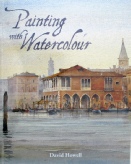David Howell PPRSMA
WORKING METHODS -
I’m always amazed at the range of colours that most paint manufacturers produce, because you don’t actually need many. I work with around 12 – 15 tried and tested pigments that I know will work anywhere and with any subject. They consist of the primary colours in warm and cool versions and a selection of earth colours.
PRIMARY COLOURS
COOL WARM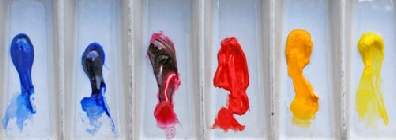
Cobalt Blue Ultramarine Blue
Alizarin Crimson Cadmium Red
Cadmium Lemon Cadmium Yellow
There are less expensive alternatives, especially for the cadmium colours but I love the strength of them.
EARTH COLOURS
Yellow Ochre : Raw Sienna : Light Red : Raw Umber : Burnt Sienna : Burnt Umber
That’s a basic 12 colour palette that gives me any colour or tone that I need. There are no greens because a whole selection of natural greens can be made from using the primary colours. I occasionally add one or two others – Cerulean blue is lovely for colder skies and water, whilst Brown Madder is a softer alternative to Alizarin. Prussian Blue occasionally gets an outing but as a very strong staining pigment, needs care and Sepia comes in handy for dark accents. I use ‘Artists Quality’ paint in both pans and tubes from various sources but predominately Winsor & Newton, Old Holland, Sennelier and Daniel Smith.
PRIMARY COLOURS
COOL WARM
Cobalt Blue Ultramarine Blue
Alizarin Crimson Cadmium Red
Cadmium Lemon Cadmium Yellow

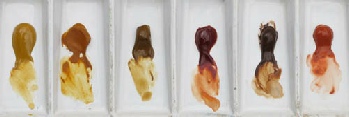
EARTH COLOURS
Yellow Ochre : Raw Sienna : Raw Umber : Burnt Sienna Burnt Umber : Light Red
That’s a basic 12 colour palette that gives me any colour or tone that I need. There are no greens because a whole selection of natural greens can be made from using the primary colours. I occasionally add one or two others – Cerulean Blue is lovely for colder skies and water, whilst Brown Madder is a softer alternative to Alizarin. Prussian Blue occasionally gets an outing but as a very strong staining pigment, needs care and Sepia comes in handy for dark accents. I use ‘Artists Quality’ paint in both pans and tubes from various sources but predominately Winsor & Newton, Old Holland, Sennelier and Daniel Smith.
PAINT BOXES
I have a collection of paint boxes, ranging from the ultimate portability of my little 12 half pan Winsor & Newton Bottle Box and Frazer Price travel box to considerably more substantial Craig Young handmade brass boxes, which tend to be used more in a studio setting. I also have a couple of Holbein palette boxes -
BRUSHES
I tend to use large brushes. Squirrel hair mops, either in flat or Petit Gris form, for initial washes – they get paint on to the paper quickly and then generally I will switch to sables with their ability to control the amount of paint released. I tend not to use anything smaller than a size 12 most of the time, although something finer like a rigger is needed for things like mooring ropes and telegraph wires. Most of my sables come from Rosemary Brushes – www.rosemaryandco.com
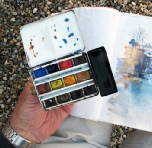
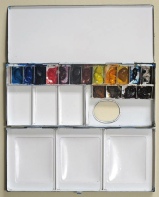
W & N Bottle box
Craig Young palette box
BRUSHES
I have always tended to use large brushes with either in flat squirrel hair mops or petit-
PAPER
I use a variety of papers, all of them 100% cotton apart from the occasional sketch on cartridge paper in a sketchbook. Apart from sketchbooks, for outside work I frequently use ¼ sheets of paper -
For general use in the studio I use sheets and the paper is invariably soaked and stretched on a board to ensure that it is flat to work on. Arches is always a reliable paper but my favourite again is the Indian hand-
My book ‘Painting with Watercolour’ covers the subject in much more detail and is available directly from the publisher at www.crowood.com or on Amazon both in Europe and the USA and from other online art material suppliers.
.
